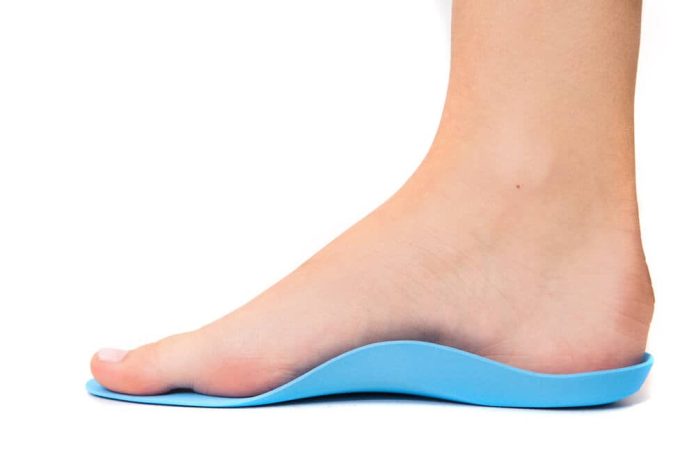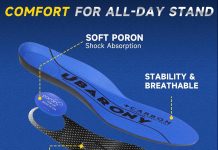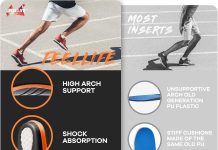Have you ever wondered if over-the-counter orthotics make a difference? Well, you’re not alone!
In our article, we will explore the effectiveness of these readily available shoe inserts that promise to provide support, alleviate pain, and improve overall foot comfort. With such a wide array of options at your local drugstore, it’s essential to understand if these affordable alternatives can genuinely deliver on their claims.
Join us as we uncover the truth behind the efficacy of over-the-counter orthotics and whether they can be a game-changer for your feet.
Types of Over-the-Counter Orthotics
Arch Supports
Arch supports are a popular over-the-counter orthotics that provide support and stability to the foot’s arch. They are designed to alleviate pain and discomfort caused by flat feet or fallen arches. Lifting the arch helps promote proper foot alignment and reduces excessive pressure on specific areas of the foot.
Heel Cups
Heel cups are orthotic devices that specifically target heel pain and plantar fasciitis. They provide cushioning and shock absorption to the heel, reducing the impact on the foot while walking or running. Heel cups are often made of soft, gel-like materials that provide comfort and support, and they can be easily inserted into most types of shoes.
Insoles
Insoles, also known as shoe inserts, are perhaps the most commonly used over-the-counter orthotics. They are designed to fit inside the shoe and provide additional support, cushioning, and stability. Insoles can help to alleviate pain and discomfort caused by various foot conditions such as arch pain, metatarsalgia, and heel spurs. They come in different shapes, sizes, and materials to suit individual preferences and foot conditions.
Foot Cushions
Foot cushions are more petite, targeted orthotic devices that provide extra padding and support to specific areas of the foot. They can alleviate pressure and pain in areas such as the ball of the foot, the toes, or the heel. Foot cushions are commonly used to address metatarsalgia, bunions, corns, and calluses. They are usually made of soft, cushioning materials that provide comfort and relief.
Toe Straighteners
Toe straighteners are orthotic devices that address toe deformities such as hammertoes or overlapping toes. They work by gently aligning and straightening the toes, relieving pain and discomfort associated with these conditions. Toe straighteners are often made of soft, flexible materials that can be easily worn inside shoes and adjusted to fit individual toes.
How Over-the-Counter Orthotics Work
Alignment and Support
One of the primary ways over-the-counter orthotics work is by providing alignment and support to the foot. They help to correct biomechanical imbalances, improve foot posture, and promote proper alignment of the bones and joints. By distributing weight and pressure more evenly across the foot, orthotics can help alleviate pain and discomfort caused by conditions such as flat feet, high arches, or irregular foot positioning.
Pressure Redistribution
Over-the-counter orthotics also work by redistributing pressure on the foot. They provide cushioning and support to areas that may experience excessive pressure or impact, such as the heels or the foot ball. By reducing pressure on specific areas and redirecting it towards more supportive regions of the foot, orthotics can help to relieve pain and prevent further damage or injury.
Shock Absorption
Another essential function of over-the-counter orthotics is shock absorption. They help to absorb and dissipate the impact and shock that occurs with each step, reducing the strain on the foot and lower limbs. This can be particularly beneficial for individuals who engage in activities that involve repetitive impact, such as running or jumping.
Biomechanical Corrections
Over-the-counter orthotics can also provide biomechanical corrections for irregular foot movements or gait abnormalities. They can help to stabilize the foot, correct excessive pronation or supination, and improve overall walking or running mechanics. By addressing these biomechanical issues, orthotics can alleviate pain and prevent further injury or strain.
Effectiveness of Over-the-Counter Orthotics
Limited Customization
While over-the-counter orthotics offer a more affordable alternative to custom orthotics, they have limitations in terms of customization. They are mass-produced and designed to fit various foot sizes and shapes. This means that they may not provide the same level of individualized support and correction as custom orthotics, which are specifically designed based on an individual’s unique foot anatomy and gait pattern.
Generalized Approach
Over-the-counter orthotics follow a more generalized approach to foot support and correction. They are designed to address common foot conditions and relieve a broader population. While this can be effective for individuals with mild to moderate foot conditions, those with more complex or severe issues may require a more customized approach. In such cases, seeking professional advice and considering custom orthotics may be necessary.
Effectiveness for Mild Conditions
Over-the-counter orthotics can be highly effective for individuals with mild foot conditions or occasional discomfort. They can provide sufficient support, cushioning, and pain relief for conditions such as plantar fasciitis, metatarsalgia, or mild pronation. However, for individuals with more severe or chronic conditions, custom orthotics or additional forms of treatment may be needed.
Cost-effectiveness
One of the main advantages of over-the-counter orthotics is their cost-effectiveness compared to custom orthotics. Custom orthotics can be significantly more expensive, often requiring additional appointments with a healthcare professional. Over-the-counter orthotics offer a more affordable option that can significantly relieve mild to moderate foot conditions. However, it is essential to consider the individual’s needs and consult with a healthcare professional to determine the most appropriate option.
Factors to Consider
Specific Foot Condition
When considering over-the-counter orthotics, it is crucial to evaluate the specific foot condition or concern. Different types of orthotics are designed to target specific issues, such as arch support for flat feet or metatarsal pads for metatarsalgia. By understanding the nature of the foot condition, individuals can choose the most suitable over-the-counter orthotic option.
Individual Biomechanics
Everyone has unique biomechanics, which refers to how their body moves and functions. This includes factors such as foot posture, pronation or supination tendencies, and gait pattern. Considering individual biomechanics can assist in selecting orthotics that provide the necessary support and correction tailored to the individual’s specific needs.
Severity of Symptoms
The severity of symptoms experienced should play a role in determining the appropriateness of over-the-counter orthotics. Individuals with mild symptoms or occasional discomfort may find over-the-counter orthotics to be sufficient in providing relief. However, if the symptoms are severe, persistent, or worsening, it is advisable to consult a healthcare professional for a more accurate diagnosis and appropriate treatment recommendation.
Lifestyle and Activities
One should also consider their lifestyle, activities, and footwear preferences when choosing over-the-counter orthotics. Orthotics must be compatible with the individual’s daily activities, whether it involves standing for long periods, running, or casual walking. It is essential to select orthotics that fit comfortably within the preferred shoes and adequately support the foot during various activities.
Quality of OTC Orthotics
When purchasing over-the-counter orthotics, it is essential to consider the quality of the product. Inferior quality orthotics may not provide adequate support or durability, leading to discomfort or a shorter lifespan. Researching and selecting reputable brands, reading customer reviews, and seeking professional advice can help ensure the product’s quality and effectiveness.
Research and Studies
Comparisons with Custom Orthotics
Several studies have compared the efficacy of over-the-counter orthotics with custom orthotics. While custom orthotics are often considered the gold standard for individualized support, research has shown that over-the-counter orthotics can provide similar benefits for individuals with mild to moderate foot conditions. However, for individuals with more complex issues or specific requirements, custom orthotics may be more suitable.
Clinical Trials
Clinical trials have also been conducted to evaluate the effectiveness of over-the-counter orthotics. These trials have shown positive results in pain reduction, improved foot function, and increased comfort when using over-the-counter orthotics. However, it is essential to note that individual responses may vary, and professional advice should be sought for accurate assessment and recommendation.
Customer Reviews
Customer reviews offer valuable insights into the effectiveness of over-the-counter orthotics. Reading reviews from individuals with similar foot conditions and concerns can provide a better understanding of the product’s benefits and limitations. It is essential to consider multiple reviews and assess the overall consensus to make an informed decision.
Expert Opinions
Expert opinions from healthcare professionals, such as podiatrists or orthopedic specialists, can provide valuable guidance when considering over-the-counter orthotics. These professionals can evaluate an individual’s needs, provide accurate diagnoses, and recommend appropriate orthotic options. Seeking the opinion of a healthcare professional is particularly important for individuals with severe or chronic foot conditions.
Common Misconceptions
One-size-fits-all Solution
One common misconception about over-the-counter orthotics is that they are a one-size-fits-all solution. While they are designed to fit a range of foot sizes and shapes, they may not provide the same level of customization and individualized support as custom orthotics. It is crucial to consider the specific foot condition and consult a healthcare professional to determine the most suitable orthotic option.
Instant Relief
Another misconception is that over-the-counter orthotics provide instant relief. While they can provide immediate comfort for some individuals, it may take time for the body to adjust to the orthotics and for long-term benefits to be realized. Gradual usage and monitoring of comfort and effectiveness are essential to achieving optimal results.
Permanent Solution
Over-the-counter orthotics are not a permanent solution for all foot conditions. They can provide temporary relief and help manage symptoms, but they may not address the underlying cause or prevent further progression of certain conditions. It is essential to seek professional advice for a comprehensive treatment plan that may include orthotics as one component.
Replacement for Medical Advice
Over-the-counter orthotics should not be seen as a replacement for medical advice. While they can offer relief for some individuals, it is crucial to consult with a healthcare professional for an accurate diagnosis and appropriate treatment plan. A qualified professional can provide personalized recommendations and guidance to ensure the best possible outcomes.
Choosing the Right Over-the-Counter Orthotics
Understanding Foot Condition
To select the right over-the-counter orthotics, individuals should have a clear understanding of their foot condition. This may involve researching common symptoms, seeking professional advice, or using diagnostic tools like foot scanners. By understanding the specific foot condition, one can choose orthotics that target the problem areas and provide the necessary support and relief.
Seeking Professional Advice
Consulting with a healthcare professional, such as a podiatrist or orthopedic specialist, is highly recommended when selecting over-the-counter orthotics. These professionals can provide accurate diagnoses, assess individual needs, and recommend appropriate orthotic options. Seeking professional advice can help ensure that the chosen orthotics suit the individual’s foot condition and biomechanics.
Trying Different Types
As there are various types of over-the-counter orthotics available, it may be beneficial to try different options to determine the most suitable one. Insoles, arch supports, heel cups, foot cushions, and toe straighteners serve different purposes and can address specific foot conditions. By experimenting with different types, individuals can find the orthotic that provides the most comfort and support for their needs.
Considering Quality and Material
When choosing over-the-counter orthotics, it is essential to consider the quality and material of the product. Opting for reputable brands and reading customer reviews can help ensure that the orthotics are of good quality and durable. Additionally, considering the material used, such as gel, foam, or fabric, can help determine which type of orthotic may best suit an individual’s comfort preferences.
Tips for Usage and Maintenance
Gradual Usage
When using over-the-counter orthotics, it is advisable to start with gradual usage. Overloading the foot with excessive support can potentially cause discomfort or the inability to adapt to the new orthotics. Gradually increasing the duration and intensity of usage allows the foot to adjust and reduces the risk of discomfort or injury.
Monitoring Comfort and Effectiveness
Individuals should regularly monitor the comfort and effectiveness of over-the-counter orthotics. This involves paying attention to any discomfort, pain, or changes in foot function while using the orthotics. Adjustments may need to be made, such as trying different types of orthotics or seeking professional advice to ensure optimal comfort and effectiveness.
Replacing when Worn Out
Over-the-counter orthotics have a limited lifespan and eventually wear out over time. It is essential to regularly assess the condition of the orthotics and replace them when signs of wear and tear become apparent. Waiting too long to replace worn-out orthotics can lead to decreased effectiveness and potential discomfort.
Cleaning and Care
Proper cleaning and care of over-the-counter orthotics are essential for their effectiveness and durability. Following the manufacturer’s instructions for cleaning and storing the orthotics will help prolong their lifespan. Regularly cleaning orthotics, especially if they come into direct contact with the feet, can prevent the buildup of odor-causing bacteria and maintain hygiene.
Precautions and Potential Risks
Aggravating Existing Conditions
While over-the-counter orthotics are designed to provide support and relief, they may not be suitable for everyone. In some cases, orthotics can aggravate existing foot conditions or cause discomfort. Individuals with severe foot conditions, open wounds, or ulcers should consult a healthcare professional before using over-the-counter orthotics to ensure they are appropriate and will not cause further complications.
Unverified Claims
It is essential to be cautious of unverified claims by some over-the-counter orthotic manufacturers. While many reputable brands produce effective orthotics, some products may make unrealistic promises or lack scientific evidence to support their claims. Reading customer reviews, seeking professional advice, and relying on reputable brands can help minimize the risk of falling for unverified claims.
Misalignment or Discomfort
Improperly fitting or poorly chosen over-the-counter orthotics can potentially cause misalignment or discomfort. It is crucial to select orthotics that provide adequate support and fit correctly within the shoe. Seeking professional advice and trying different types of orthotics can help minimize the risk of misalignment or discomfort.
Delayed Treatment
Relying solely on over-the-counter orthotics for treating severe or chronic foot conditions may lead to delayed treatment. While orthotics can provide temporary relief, it is essential to consult a healthcare professional to address the underlying cause and determine the most appropriate treatment plan. Delaying treatment may worsen the condition or lead to further complications.
Conclusion
Over-the-counter orthotics can effectively provide support, relief, and improved foot function for individuals with mild to moderate foot conditions. They offer a cost-effective alternative to custom orthotics and can alleviate pain and discomfort in many cases.
However, it is essential to consider specific foot conditions, individual biomechanics, severity of symptoms, lifestyle factors, and the quality of the orthotics when making a decision. Seeking professional advice and understanding the limitations of over-the-counter orthotics can help individuals choose the right orthotics while balancing cost and effectiveness.
Remember, over-the-counter orthotics should be seen as a complementary treatment option and not replace professional medical advice. By considering these factors and applying the tips for usage and maintenance, individuals can make informed decisions and experience the benefits of over-the-counter orthotics.








































